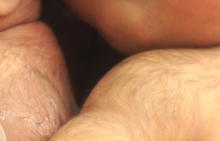Lanugo
| Lanugo | |
|---|---|
 | |
| Pronunciation | |
Lanugo is very thin, soft, usually unpigmented hair that is sometimes found on the body of a fetus or newborn. It is the first hair to be produced by the fetal hair follicles, and it usually appears around sixteen weeks of gestation and is abundant by week twenty. It is normally shed before birth, around seven or eight months of gestation, but is sometimes present at birth. It disappears on its own within a few weeks.[3]
It is replaced by hair covering the same surfaces, which is called vellus hair. This hair is thinner and more difficult to see. The more visible hair that persists into adulthood is called terminal hair. It forms in specific areas and is hormone-dependent.[4] The term is from the Latin lana, meaning "wool."
Humans
[edit]Fetal development
[edit]During human development, the lanugo grows on fetuses as a normal part of gestation, but it is usually shed and replaced by vellus hair at about thirty-three to thirty-six weeks of gestational age. As the lanugo is shed from the skin, it is normal for the hair to be consumed by the developing fetus, since it drinks from the amniotic fluid and urinates into its environment. As a result, lanugo contributes to the newborn baby's meconium. The presence of lanugo on newborns is not necessarily a sign of premature birth, as it is also seen on infants born at thirty-nine weeks of gestation (full term).
Lanugo functions as an anchor to hold the vernix caseosa on the skin. Together they protect the delicate fetal skin from being damaged by the amniotic fluid.[5] The vernix caseosa also helps to prepare the fetus for life outside the womb. It provides lubrication for birth and contributes to thermoregulation, prevention of water loss, and innate immunity. Without the lanugo to anchor the vernix caseosa, these functions would be compromised.[6]
Malnutrition
[edit]In the absence of fat, lanugo grows to serve as a replacement insulator, and thus can be observed in malnourished patients, including those with eating disorders. When found along with other physical symptoms, for example, lanugo can help a physician make a diagnosis of anorexia nervosa or bulimia nervosa.[7]
Teratoma
[edit]It is often found in teratomas (congenital tumours).[citation needed]
Other mammals
[edit]Lanugo is also common on other mammals. For example, seals[8] and elephants[9][10][11] are often born with a covering of lanugo. Some species of fetal whales and dolphins also have lanugo.[12][13]
References
[edit]- ^ Saunders, an imprint of Elsevier, Inc., Dorland's Medical Dictionary for Health Consumers. "Lanugo : definition". TheFreeDictionary. Retrieved 17 February 2013.
{{cite web}}: CS1 maint: multiple names: authors list (link) - ^ "lanugo". Random House Webster's Unabridged Dictionary.
- ^ "Definition of Lanugo". MedicineNet: medterms medical dictionary. Retrieved 17 February 2013.
- ^ Ascher-Walsh, Charles J. "What is lanugo?". Pregnancy&Baby. SheKnows. Retrieved 7 February 2013.
- ^ Moore, Keith L (Dec 19, 2011). The Developing Human: Clinically Oriented Embryology. Elsevier. p. 98. ISBN 978-1437720020.
- ^ Singh, G; Archana (2008). "Unraveling the mystery of vernix caseosa". Indian Journal of Dermatology. 53 (2): 54–60. doi:10.4103/0019-5154.41645. PMC 2763724. PMID 19881987.
- ^ Williams, Pamela M.; Goodie, Jeffrey; Motsinger, Charles D. (15 January 2008). "Treating Eating Disorders in Primary Care". American Family Physician. 77 (2): 187–195. PMID 18246888.
- ^ Androukaki, E.; Fatsea, E., 't Hart, L., Osterhaus, A.D.M.E., Tounta, E. and Kotomatas, S. (May 2002). "Growth and Development of Mediterranean Monk Seal Pups during Rehabilitation". Monachus Science Posters. 5 (1): This poster was presented at the 16th ECS (European Cetacean Society) Conference, "Marine Mammal Health: from Individuals to Populations", 7–11 April 2002, Liege, Belgium. Retrieved 13 April 2013.
{{cite journal}}: CS1 maint: multiple names: authors list (link) - ^ Ishwaran, Natarajan (1993). "Ecology of the Asian Elephant in Lowland Dry Zone Habitats of the Mahaweli River Basin, Sri Lanka". Journal of Tropical Ecology. 9 (2): 169–182. doi:10.1017/S0266467400007148. JSTOR 2559288. S2CID 84830688.
- ^ The Hair, Paul MacKenzie, Elephant Information Repository website
- ^ Elephant Hair, Elephant Anatomy, Animal Corner website Archived 2007-11-17 at the Wayback Machine
- ^ Coyne, Jerry A. (14 January 2010). Why Evolution is True. OUP Oxford. p. 89. ISBN 9780191643842.
- ^ "11 Cool Facts About Whales, Dolphins, and Porpoises". NOAA Fisheries. 16 February 2021.
